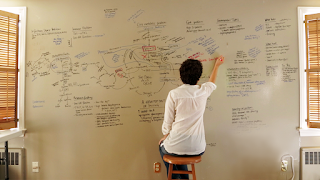I feel as though my health has started upon a roller coaster gradually building over the last two years to now. I've been on a search for managing worsened chronic abdominal pain and the addition of chronic nausea since 2015 after an unexpected hospitalization. Since then, my health has increasingly worsened this year through intestinal blockages and culminating in a C-Diff infection.
Based on my symptoms worsening to include extreme early fullness after my latest intestinal blockage in August of this year, I'm led to believe that I must have developed a C-Diff infection around the same time. Upon completing a round of antibiotics, my early fullness ceased. I continue to have chronic abdominal pain, severe bloating, and chronic nausea however.
With the urging of others amongst the chronic illness/bowel health groups, I spoke to my doctor about trying Creon. Creon is a medication that helps with digestion by replacing pancreatic enzymes to break down food. It is be taken with every meal or snack and varies in dosages available. My doctor agreed to let me try Creon with a dosage of 24,000 USP capsule to be taken one capsule three times a day. This dose contains 24,000 USP units of lipase, 76,000 USP units of protease, and 120,000 USP units of amylase. It is a delayed release capsule and it isn't absorbed in the GI tract but rather is excreted through stool. It is not to be crushed or chewed and online forums advised not to keep it in your mouth for long as it will burn your mouth. Due to my commercial prescription insurance, I was able to download a savings card and obtain the medication for $5 for a 30 day supply at my local retail pharmacy. Without this savings card, it would have cost me $50 for a 30 day supply.
 |
| Creon capsules |
I decided to let my backside heal from this painful night before trying another dose of Creon. I realized I needed to at least try Creon a second time to see if the pain was reoccurring as my skin is sensitive and I do experience butt burn periodically due to the Short Bowel. My stomach though did feel incredibly better the next day after a dose of Creon the night before. I was able to eat lunch the next day with very minimal bloating or pain. My hope was strengthening that Creon was the answer but only if the butt burn wasn't a side effect. I waited a couple more days before trying Creon again prior to eating an evening meal. That night I did have mild butt burn but nothing like that first night. This was a tolerable pain that didn't interfere with my activity or sleep.
With this improvement, I started taking the Creon once per day in the evenings as I was leery of taking it at work in fear that the intense butt burn would return. I finally braved it and took one capsule at lunch and a second at evening and managed well with minimal pain for a couple of days. I had the intention to add the third capsule with something small to eat at breakfast time but never made it this far. The pain would start to increase as one day I took a capsule mid morning and a second at lunch time. I believe the capsules were taken too close together resulting in pain and so I skipped the evening dose. The following day I again took a capsule at lunch with the intention of taking a second at evening, however, the pain was too bothersome to follow through with a second dose that day. And so I decided to give my bum the weekend off from the Creon.
Around this time, I noticed that I seemed to be having more bloody stools. Again, this is not uncommon for me as I have intestinal ulcers that won't completely heal even with medication. The ulcers are unable to fully heal on account of my Short Bowel and are worsened if I become constipated as the stool has more time allowed to irritate the ulcers. Since the Creon is not absorbed in the GI tract and excreted through stool, it would make sense that it would also irritate my intestinal ulcers.
I decided to take a break from the Creon as I have come to the conclusion that Creon, although helpful, is not the right medication for me due to the increased frequency of bloody stools and butt burn. I might finish my prescription over a period of time, however it would not be as prescribed as my body is unable to tolerate three Creon capsules a day and at times not even one.
I searched online for remedies to help reduce the bloating as I believe my abdominal pain would be much more tolerable if the bloating was resolved. I already take Simethicone and Bentyl with every meal to reduce gas and intestinal spasms to reduce bloating and pain. Prior to the last intestinal blockage, these medications worked well to manage my pain. Now I've added Beano, Mylanta, and Essential Oils to my regiment as a new experiment to address the bloating.
 Beano is an enzyme to help digest grains, vegetables, and legumes. Beano also produces another product Beano + Dairy Defense for those requiring enzymes to break down dairy as well as grains, vegetables, and legumes. I take two tablets prior to eating. When I'm home, if I feel like I need a bit more help I take a gulp of Mylanta before or after eating. When my stomach remains bothersome, I topically apply a few drops of Essential Oils. This combination in addition to my prescription medications seems to be managing my discomfort and symptoms well now thus far.
Beano is an enzyme to help digest grains, vegetables, and legumes. Beano also produces another product Beano + Dairy Defense for those requiring enzymes to break down dairy as well as grains, vegetables, and legumes. I take two tablets prior to eating. When I'm home, if I feel like I need a bit more help I take a gulp of Mylanta before or after eating. When my stomach remains bothersome, I topically apply a few drops of Essential Oils. This combination in addition to my prescription medications seems to be managing my discomfort and symptoms well now thus far. To further experiment and in an attempt to reduce financial burden, I decided to try replacing Beano with a food enzyme mixture called Digestabs by Puritan Pride. The cost difference is incredible. I was able to purchase 3 bottles of Digestabs with 60 tablets per bottle for $10. It follows the same rules as Beano - take two tablets prior to meals. Within an hour of taking my first dose of Digestabs, I started having butt burn even without using the restroom. I decided to further research Digestabs and found that these tablets include amylase and pancreatin. Pancreatin is composed of amylase, lipase, and protease - the three enzymes within Creon although at much smaller dosages. My body doesn't react well to one or a combination of these three enzymes. I discovered that Beano is composed of the enzyme alpha-galactosidase (a-GAL). I'm not sure the difference between these enzymes but my body definitely reacts differently to them.
To further experiment and in an attempt to reduce financial burden, I decided to try replacing Beano with a food enzyme mixture called Digestabs by Puritan Pride. The cost difference is incredible. I was able to purchase 3 bottles of Digestabs with 60 tablets per bottle for $10. It follows the same rules as Beano - take two tablets prior to meals. Within an hour of taking my first dose of Digestabs, I started having butt burn even without using the restroom. I decided to further research Digestabs and found that these tablets include amylase and pancreatin. Pancreatin is composed of amylase, lipase, and protease - the three enzymes within Creon although at much smaller dosages. My body doesn't react well to one or a combination of these three enzymes. I discovered that Beano is composed of the enzyme alpha-galactosidase (a-GAL). I'm not sure the difference between these enzymes but my body definitely reacts differently to them.I decided for my well-being I need to stick to Beano even if it does cost more.
Read next my review of the Essential Oils I've been using for further information and results.















